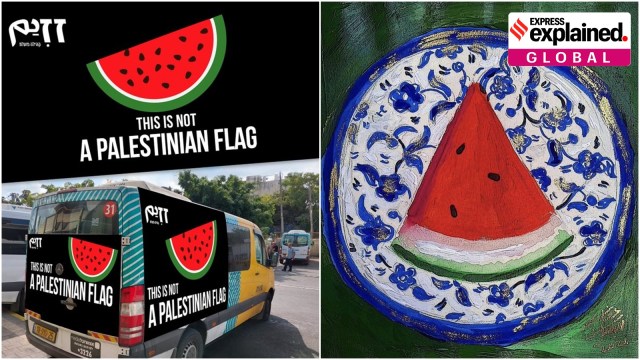While the reason for why a watermelon is considered a symbol of the Palestinian struggle is simple enough, the history of its use is more complicated.

Why a watermelon
A watermelon when sliced shows the colours of the Palestinian flag — red, green, black, and white. As carrying and displaying the Palestinian flag has often been barred by Israeli authorities, a watermelon is used to symbolise it instead. On social media, many claim that posts with overt Palestinian symbols are restricted by the US-headquartered bigger platforms, and hence, the sliced watermelon comes in useful here too.
The watermelon is also widely cultivated in Palestine, from the West Bank to Gaza, and features prominently in Palestinian cuisine.
Its use in protests
Palestine has been on the boil the whole of this year, much before the Hamas attack that triggered the bloodbath in Gaza by Israel. In January, Israeli National Security Minister Itamar Ben Gvir claimed he had instructed the police to tear down any Palestinian flags flown publicly, after a terror convict waved the flag after his release from prison, The Times of Israel reported.
Flowing the Palestinian flag is not legally banned in Israel, but the police often crack down, claiming the flag could “disturb peace”. As the arrests continued, in June, an organisation called Zazim began adding images of sliced watermelons on taxis playing in Tel Aviv, with the accompanying text reading “This is not a Palestinian flag”.
Another prominent example is the work of Palestinian artist Khaled Hourani, who in 2007 painted a slice of watermelon for the Subjective Atlas of Palestine project. His work received wide viewership, and served to associate the watermelon with the Palestinian cause strongly.
Origins
Story continues below this ad
What is less clear, however, is how the watermelon first came to be used in protests. While many Western media organisations have reported that it was a prominent symbol of resistance during the First Intifada (1987-1993), Arab news websites and blogs have contradicted this.
After the 1967 Arab-Israeli war, Israel occupied West Bank and Gaza, and criminalised public displays of the Palestinian flag. Thus, it is plausible that sliced watermelons were used during the First Intifada, which was against the occupation.
However, in a 2021 report, Abu Dhabi-based The National reported, “The story has become a bit of a contemporary myth, proliferated recently on social media, with its true origins buried in various retellings and reposts.”
Decolonize Palestine, a website claimed to be run by two Palestinians living in Ramallah, says, “There is no mention at all of this practice in the literature of the first Intifada [in English and Arabic]. There are references to people using the watermelon as an example of the banned colour combination… but none of the widespread use of watermelon slices as a political statement or as a substitute for the Palestinian flag.” They also add, “…we reached out to several members who were active in the popular committees of the Intifada regarding this issue, none of them could recollect anyone ever using watermelons as symbols of resistance.”
Story continues below this ad
In fact, many of those who mention the First Intifada rely heavily on two sources — a 1993 The New York Times report, and a story involving artists Sliman Mansour, Nabil Anani and Issam Badr. As The National reports, an exhibition by the artists in 1980 was “shut down by the Israeli army as the artworks were deemed political and bore the Palestinian flag and its colours. Confronting the officer, Badr asked, “What if I just want to paint a watermelon?”, to which he replied, “It would be confiscated”.”
The NYT article, written after Israel and Palestine recognised each other as part of the Oslo Accords and displaying the Palestinian flag was no longer criminal, said, “In the Gaza Strip, where young men were once arrested for carrying sliced watermelons—thus displaying the red, black and green Palestinian colors—soldiers stand by, blasé, as processions march by waving the once-banned flag.”
However, the director of the Government Press Office Jerusalem wrote to the newspaper, saying, “Having investigated the matter with the proper authorities, I can state that such arrests have never been official Israeli policy. If such an isolated and unsanctioned act did occur, no individual was ever prosecuted under such innocent circumstances.” This detail seems to have been later retracted by The NYT.
Today, even though the origin of the use of the watermelon is unclear, it is widely accepted as a symbol of Palestinian resistance.








































